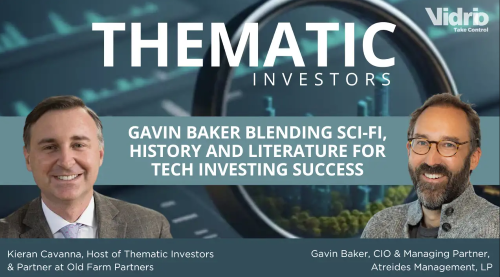In our pursuit of deeper insights for our institutional investment network, one event shines above the rest. Dive into our newest blog exploring the perspectives shared at the ALTSNY event. Vidrio Financial captures the highlights concerning allocator strategies for better portfolio construction, digital assets, carbon credits, and real assets.
By: Ray Casaletta, Associate Director Vidrio Financial
Taking cover indoors during the last several weeks was one way to fight the heat in Manhattan, and the timing of the ALTSNY event couldn't have been better for those interested in learning about the newest developments in institutional investing and alternatives. The agenda, which included real assets, private equity, hedge funds, global asset allocation, and private markets, was jam-packed with insightful information and powered by the CAIA Association, CFA Society of New York, and Markets Group. Vidrio Financial was able to reserve a spot for this event, and I was able to leave with some helpful knowledge for our blog readers, friends, coworkers, and clients. Below are the key highlights of ALTSNY (as seen from the Vidrio perspective).
Institutional Portfolio Construction:
The first session that I attended titled Portfolio Construction – Finding Opportunities in the Current Landscape was moderated by Steve Houston, Managing Director, Co-Head of iCapital Solutions, iCapital, and featured Gbenga Oladeji, CFA, CAIA, Vice President - Head of Private Markets, Johnson & Johnson Benefit Trust Plan, Geeta Kapadia, CFA, Chief Investment Officer Fordham University, Patrick McGowan, Managing Director, Head of Alternative Investments and Manager Research, Sanctuary Wealth, and Michael Elio, Partner, StepStone.
Over more than seven years, the Johnson & Johnson private market program has expanded to include $4.5 billion in pension assets. According to Gbenga, for every dollar invested in private markets, roughly 50% goes into private equity, 30% goes toward private credit, and the remaining portion is allocated to real estate or real assets. From the standpoint of the public market, Johnson & Johnson's Benefit Trust Plan allocates to a small number of managers regularly; however, they frequently rebalance to keep the asset allocations aligned with their mandated benchmarks.

Geeta Kapadia, CFA, Chief Investment Officer Fordham University oversees approximately $1bn in AUM. Geeta currently allocates 75% to growth investments across multi-asset class portfolios, while the remaining 25% is set to risk-diversified assets, hedge fund strategies, absolute returns, and more. Geeta’s team is consistently looking to make new commitments but admits that the team is currently going against popular opinion on new commitments that would involve private credit. Fordham’s team is looking at evergreen funds to determine the level of flexibility in terms of liquidity and being more open-ended in comparison to other traditional fund structures.
Vidrio is seeing many allocators fighting for a piece of the private credit space through either direct investment or co-investment. The waves many allocators are making in this space signal a never-ending investor appetite for this asset class. We have also seen major banks partnering with private lending partners to broaden and diversify their revenue streams. Banks bring their vast network to connect lenders and borrowers, while private credit firms can offer greater flexibility and customization in the deals that they’re tailoring to the institutional investor.
Digital Asset Investing
The next session was a fireside chat with Craig Saim, Chief Legal Officer, Grayscale Investments. Craig maintains compliance standards with SEC guidelines for ETFs that are built around digital assets. Greyscale is the largest digital asset investor and is actively targeting institutional investors who are interested in these types of assets but require an ETF structure to make a secure allocation. For the team at Greyscale, the success of digital assets must come in the form of an ETF due to the increased scrutiny and legislation that many regulators insist on to protect the underlying investor. Greyscale Investments also takes a hard look at the various sectors across the institutional markets to see where it makes sense to develop a sector product.
Some of the sectors that are showing promise, according to Craig, include entertainment, infrastructure – specifically cloud storage and bandwidth, currency exchanges, and more. One example that points to increasing investor appetite around digital asset ETFs is Blackrock’s spot Bitcoin ETF, which took less than 50 days to launch and pass $10 billion in AUM, along with earlier 2024 approvals by the SEC for ETFs that align with Ethereum is helping to gain institutional investment support. Still, concerns are being raised not only from a compliance standpoint, (as Craig mentioned at the event) but also from Wall Street where current digital asset ETFs heavily rely on Coinbase, raising concerns about centralization under a single custodian and counterparty risk. According to a recent study by EY-Parthenon digital asset interest is rising for institutional investors. Per the survey, 69% of allocators are planning to increase their allocations to digital assets in the next two to three years. 93% of investors believe in the long-term value of these digital assets. To see more of the survey findings be sure to visit the following link:
Also, be on the lookout in the next few weeks for Vidrio’s write up on our artificial intelligence survey. We look at how allocators are thinking about artificial intelligence usage and what are some of the barriers to full AI adoption.
Private Credit
Private Credit is driving many discussions across investor allocations especially given market concerns like inflation, geopolitics, interest rates, and overall volatility. The Keynote Panel: Private Credit: Impacts of the Economic Climate moderated by Yasho Lahiri, Partner, Kramer Levin, featured insights from Rich Nuzum, CFA, Executive Director, Investments and Global Chief Investment Strategist, Mercer, Jennie Benza, Private Markets, GE Investment Management Corp, Eric Fox, Tax Principal, Deloitte Jason Mehring, Managing Director, BlackRock, did a great job framing how allocators are looking at the $1.7-$2.0 trillion private credit market today.
Private credit is defined as a means for lending by non-bank institutions, which typically includes private equity firms and alternative asset managers, to small and mid-sized businesses. Many agreed that education in private credit is still ongoing as no one wants a client to invest in something that they may not fully understand. When asked about assessing new asset classes as they relate to risk, panelists quickly stated that it’s not a one-size-fits-all approach, most importantly with any private credit analysis, transparency is key. This level of transparency in private credit is necessary as investors should investigate their tax obligations and any regulatory risks associated with the asset class.
One of the last questions raised on the panel was how managers can differentiate themselves where private credit is becoming more commoditized. The top answers are reflected below with the Vidrio perspectives included directly underneath:
- Longevity and track records are key in the private credit space. Allocators should be asking how has this asset class been tested and what are some of the performance concerns? Have these funds made it through any sort of stress test?
Vidrio perspective: Stress testing is a key differentiator in the Vidrio platform. Clients are afforded the benefit of having historical scenarios and single-factor shocks included in every client portal. Vidrio Financial also works with our allocator clients to add additional scenarios and factor shocks, to complete the picture of their portfolio performance and advanced reporting.
- Another point for investors to focus on is how long has the private credit fund team been together, and whether there have been any occurrences of style drift?
Vidrio perspective: At the institutional level, style drift can occur simply through positive portfolio performance over time, thereby shifting allocations within a given portfolio. It may even occur through a fund management change. Vidrio tracks these changes from past, present, and future mandates eliminating the guesswork that investment teams may encounter through multiple searches, platforms, or spreadsheets.
- For allocators getting into private credit, have you considered innovation capture?
Vidrio perspective: Innovation is critical but without a technical roadmap many allocators quickly find out that they’re not aligned with industry or market developments. Vidrio closely partners with our clients to ensure that our platform keeps pace with innovations to handle complex asset class allocations and more. Due diligence tasks can be incorporated into various workflows for allocators to quickly assess where bottlenecks might exist in manager selection. This helps to quickly customize manager selection while streamlining allocator operations.
- With 20+ major sub-flavors of private credit are managers or investors focused on the right one?
Vidrio perspective: Vidrio tracks over 2,000 funds and over 1.0MM data points processed each month for our clients. Considering those 20+ sub-flavors of private credit, allocators need a partner that can assist in growing the total portfolio approach.
Natural Capital Investments:
Similarly positioned to private credit’s ability to protect allocators from inflation, the next session focused on timberland and farmland as a growing area that many multi-asset class allocators target when looking at differentiated revenue streams, cash yield, and carbon credits.
The keynote, titled Expanding the Efficient Frontier with Natural Capital Investments, moderated by Judy Chambers, Managing Principal & Private Markets Consultant, Meketa Investment Group with contributions from Michael Strzelecki, CFA, Managing Director, Senior Timberland Portfolio Manager, Manulife Investment Management, June Yearwood, Managing Director & Head of Private Specialty Strategies, Church Pension Group, Chris Teryazos, President, Aetos Capital highlights portfolio strategies that consist of agriculture and the ‘efficient frontier’. From the panel’s perspectives allocations into this asset class are typically around 3% with new investments focused on improving risk-adjusted returns.
Compliance carbon markets feature heavily in investment strategies as carbon credits can be bought and sold depending on the organizations or companies that have exceeded their carbon targets. Panelists agreed that the main driver of returns is how ambitious the carbon programs are within each state. Institutional allocators should find programs where the emission reduction programs are aggressive enough to tip the market scales towards alternative forms of energy. From the panelist’s viewpoint, the U.S. is falling behind due to a patchwork of regional programs across the 50 states, with no view of a unified federal program in sight. Europe and Japan are taking a more serious view of carbon markets and how they might benefit investor diversification strategies. Cap and trade programs also feature across this asset class, and panel discussion, as there are increased efforts in climate control. However, cap and trade programs are not without their risks, including:
1. Emission credits versus clean energy conversion – credits are typically cheaper to buy on the secondaries market than converting to cleaner energy alternatives.
2. Emissions reports leave a lot of room for interpretation, allowing companies to skip monitoring implementation and execution.
3. Caps may be set too high allowing more emissions not less, especially from the highest polluters.
Real Assets/Real Estate:
When considering today’s multi-asset class portfolio, allocators tend to examine how much diversification can be achieved through real assets and real estate? The panel titled Real Assets and Real Estate moderated by David Allen, CFA, Chair of the Board, CFA Society New York, Managing Director, Octane Investments with insights from Cynthia Maasry, Managing Director, Mission Investments, Trinity Church Wall Street; Shahab Moreh, Partner, Global Real Estate Practice Leader, Mazars USA LLP; Michael Brand, Partner, Global Head of Real Assets, Mercer; Shawn Lese, Chief Investment Officer and Head of Funds Management, Americas, Nuveen attempted to answer that question.
The panel agreed that it’s a perfect time in multi-asset class allocations to consider real assets as more next-gen advisors are hyper-focused on this asset class to protect themselves from persistent inflation, higher interest rates, and other geopolitical concerns. On the flip side, real estate has fallen in value, mainly as an outcome of a lack of construction following the pandemic. Multifamily demand amongst the aging millennial demographic is on the rise, however, interest rates are preventing buyers from entering the market. This is further supported by most of the population spending more than 30% of their income on rent. Panelists were then asked which sector of real estate takes up most of their time when considering future strategies, the choices were:
a. Offices
b. Hospitality and Retail
c. Real Estate Debt
All panelists agreed that the office market will be in a bad spot for quite some time as hybrid work is here to stay and the expectations that people will return to pre-pandemic levels (5 days a week) are no longer a reality. Investors should therefore consider their ROI as it relates to real estate investments as most tenants have long lease terms and will re-evaluate their square footage needs as their lease nears the end. Due to these factors panelists believed that there would be added volatility in real estate for institutional investors in the short term, but distressed opportunity sleeves should come to light as inventory is worked through and the volatility settles a bit more.
Private Equity/Secondaries:
Does private equity and the secondaries market continue to hold the ability to boost liquidity for LPs across hospitality, energy, transportation, and more? The last session that I attended at ALTSNY titled Opportunities Around Private Equity and Secondaries was moderated by Zhuoying “Joy” Xu, CFA, Senior Investment Director, Verizon Investment Management Corp. with insights from Maurice Gordon, CFA, Senior Managing Director and Head of Alternative Investments, Guardian Life Insurance; Ashmi Mehrotra, Co-Head Private Equity Group, Portfolio Manager, J.P. Morgan Asset Management; Megan Malone, Head of Private Equity and Real Estate for the Americas, Citi Global Wealth Investments; David DiPietro, Managing Director, T. Rowe Price, and Pete Keliuotis, CFA, Executive Vice President, Head of Alternatives Consulting, Callan.
The start of the discussion focused on the question of whether allocators are considering increasing their private equity allocations. Panelists answered with a resounding yes, pointing to the fact that PE has outperformed the public markets on a direct alpha basis – 24 of the last 25 years. Panelists further believe that more LPs should access the secondaries market as they’re currently seeing between a 5-20% discount on high-quality buyout funds. Due to slower-than-normal fundraising in private equity, many GPs are providing co-investments to LPs on a no-fee, no-carry basis, this is a massive opportunity, but LPs should be looking for investments that are innovative and unique. When asked about the private equity lens on where investors should focus their attention, panelists mentioned that
all hold key diversification goals for institutional investors. This helps to support the earlier session beliefs around natural capital investments through inflationary protection and carbon trading.
The time spent at the ALTSNY event powered by the CAIA Association, CFA Society of New York, and Markets Group was extremely valuable not only from the panelists providing their views on portfolio construction, private credit, digital assets, natural capital, real assets, and private equity but through the various networking opportunities.
If you are an institutional investor eager to learn more about Vidrio Financials’ methods for improving data collection, risk monitoring, and the total portfolio approach for today’s multi-asset class portfolios please book an appointment on my calendar today. I’d be happy to guide you through a demo of our platform to show how we can innovate front, middle, and back-office operations. Thanks for reading, and I look forward to partnering with your team in the future.


-1.png?width=100&height=100&name=MicrosoftTeams-image%20(10)-1.png)



